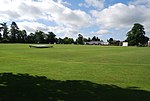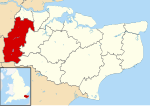Sevenoaks

Sevenoaks is a town in Kent with a population of 29,506 situated south-east of London, England. Also classified as a civil parish, Sevenoaks is served by a commuter main line railway into London. Sevenoaks is 21 miles (34 km) from Charing Cross, the traditional centre of London. It is the principal town of the Sevenoaks district, followed by Swanley and Edenbridge. A settlement was recorded in the 13th century, when a market was established. Construction of Knole House in the 15th century helped develop the village. Sevenoaks became part of the modern communications network when one of the early turnpikes was opened in the 18th century; the railway was relatively late in reaching it. In the 21st century, it has a large commuting population. The nearby Fort Halstead defence installation was formerly a major local employer. Located to the south-east of the town is Knole Park, within which lies Knole House. Educational establishments in the town include the independent Sevenoaks School and Knole Academy.
Excerpt from the Wikipedia article Sevenoaks (License: CC BY-SA 3.0, Authors, Images).Sevenoaks
Chestnut Lane,
Geographical coordinates (GPS) Address Nearby Places Show on map
Geographical coordinates (GPS)
| Latitude | Longitude |
|---|---|
| N 51.2781 ° | E 0.1874 ° |
Address
Chestnut Lane
Chestnut Lane
TN13 3AR , St John's
England, United Kingdom
Open on Google Maps








